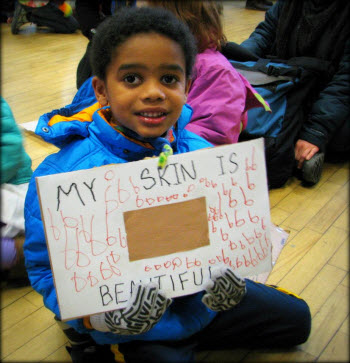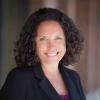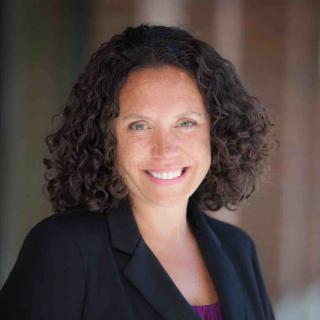 As a social worker, I thought I was pretty aware of the various “isms” that run deep in our society, from overt acts of discrimination to institutionalized oppression. As a Jew, I am also part of a minority group, but not one that is visible from the outside. As I moved toward marriage and parenthood, I specifically chose where I lived because I wanted to be part of a diverse community. I thought about how I would teach my children about various cultures and religions. I chose Giddens School for preschool through elementary grades for my children specifically because of the school’s diversity and social justice mission.
As a social worker, I thought I was pretty aware of the various “isms” that run deep in our society, from overt acts of discrimination to institutionalized oppression. As a Jew, I am also part of a minority group, but not one that is visible from the outside. As I moved toward marriage and parenthood, I specifically chose where I lived because I wanted to be part of a diverse community. I thought about how I would teach my children about various cultures and religions. I chose Giddens School for preschool through elementary grades for my children specifically because of the school’s diversity and social justice mission.
I expected to raise children who saw everyone as equal, regardless of race, religion, sex, gender, ability, marital status, family structure, and socio-economic status. I was ready to help the next generation create a new world where every individual is valued for who he or she is.
What I didn’t realize was that I had a huge blind spot. When my oldest daughter was about 3, her class was very diverse. We drove by a mural of Dr. Martin Luther King Jr. every single day on the way to and from school. One day, as we were driving by, she said, “My teacher is black like Martin Luther King, and so are some of my friends in my class.” I answered, “Yes, you are right, they are all black.” She then went on to count each person in her class who had skin that was dark brown, light brown and pink, and after that, moved on to categorizing classmates by hair color. I thought, wow, this makes total sense. One of the earliest ways babies and young children make sense of their world is by sorting. There are thousands of toys parents can buy based solely on the diverting exercise of sorting items by color, shape, and size.
While we had answered questions about different cultures and religions, we usually focused on what was the same, what different cultures shared. We certainly didn’t want to spend time on difference, because we hoped our child would grow up free of seeing what is different, especially around race. Yet, my child had been working this out for herself, likely for a long time. By 6 months, babies find differences in skin color and gender interesting, and will focus longer on images of people of different gender and skin color than their own. While looking at the images longer does not indicate a racial preference, it does mean the babies were noticing something different (Katz, 2003; see footnote). So why hadn’t we been talking about difference? Did I really believe that not pointing out difference would keep my child from seeing difference? And, did I really not want her to see difference? The answer to both of these questions was NO!
Soon after, I had a name for my blind spot. Po Bronson and Ashley Merryman had just named it in their new book NurtureShock. Like them, I had been unknowingly subscribing to Diverse Environment Theory, the belief that just being a part of a diverse environment and regularly exposing your children to different races and cultures was better than talking about race. Their theory, and my mind, went on to say, let’s not draw attention to race so that our kids grow up viewing everyone as the same.
Once I understood my underlying false assumptions, it was amazing to me that I had missed it. I had spent so much time reflecting over the years on my own experience of society, what privilege I have, what hurt I had felt being a part of a minority group, how my privilege impacts those I work with and so on. I had a background in child development and work with families, and yet, here I was with a blind spot the size of a semi truck. You can’t change what you can’t see, and now I was ready to do something different. Luckily, the teachers at my children’s school were having the conversations with my 3-year-old that I was not having yet. I was now ready to join in and add more depth to the dialogue as a family.
Many liberal Caucasian parents have found themselves in the same boat. In fact, 75% of white parents never or almost never talk about race, while non-white parents are three times more likely to have had discussions around race with their children (Brown, Tanner-Smith, Lesane-Brown & Ezell, 2007; see footnote). For families that are part of a minority or marginalized culture, these conversations may come up regularly as family members experience subtle or not so subtle oppression because of their race or culture.
No matter our life experience, there are concrete ways we can facilitate our children’s awareness and maybe even increase our own along the way:
Notice and ask questions. Since we know our kids are noticing differences and categorizing from the time they are babies, we need to take the lead and add to their understanding. When looking at picture books, feel free to use descriptive words to talk about skin color. Talk about all of the varied shades of human skin. If we don’t use the words, our children get the idea that they shouldn’t as well. Talk about differences in bodies, abilities, and family structure when opportunities present themselves. Explore the different clothing worn by people around the world. The more comfort we have in talking about these things, the more our children will as well.
Acknowledge and answer questions. There’s the moment all parents fear, our child loudly says, “He’s fat,” or asks, “Why is she in a wheelchair?” while in line at the grocery store. The natural instinct is to shush our child. We don’t want to draw more attention to the situation; we don’t want to hurt feelings. Many parents don’t know what to say in those moments. However, our attitude in those moments conveys a great deal about our own beliefs. If your child is pointing and staring, though, you can let them know that sometimes people feel uncomfortable when we point at them.
First off, acknowledge that your child has noticed something. “You noticed that his body is different than yours,” or, “You notice that she moves around in a wheelchair instead of walking.” You can then say, “Each person is unique, and it looks like you might have some questions about that.”
When answering questions, use non-judgmental, descriptive words such as “that woman is Asian,” or, “Yes, he uses a cane to walk.” This helps build their diversity vocabulary. If you are unsure of what to say in the moment, you can let your child know that you would like to think about it and continue the discussion at a later time.
Exposure still matters. While simply exposing our kids to diverse environments is not enough, it is still a critical part of raising culturally and socially aware kids. Besides, this exposure becomes material for having meaningful discussions with our children.
Food and music are both great ways of introducing our children to different cultures. Eat at restaurants with cuisine from other countries or visit museums that have exhibits on different cultures. If you ever find yourself in Greensboro, North Carolina, be sure to visit the International Civil Rights Center and Museum. This museum is built around the Woolworth lunch counter where four students began a journey that changed our country. Our oldest was 5 when we visited and she was immediately deep in thought as she processed all she was seeing. She spoke up in our tour group and said to the guide how much she had learned about what she was seeing at her school in Seattle. Both the guide and the rest of the group were amazed at her level of understanding of the Civil Rights movement in America.
Many cities have cultural centers and celebrations for a wide variety of groups. My own family enjoys visiting the wonderful Festál Cultural Festivals that take place at Seattle Center throughout the year. We get to hear music, see art and visual performances, and try out new foods. More importantly, we get to spend time with people who may be different from us and learn from each other.
Take a look at the toys and books you have in the house. Are they all representative of your culture or the dominant culture? Dolls with different skin color and toys from different parts of the world add to your child’s understanding and appreciation of diversity and allow space for conversation.
Children’s books are another fantastic way to explore diversity — both similarities and differences.Young children love looking at faces, so books with all different types of people in them are usually a hit. As children get older, historical fiction and biographies can deepen their understanding of diverse people throughout history. While these may bring up challenging questions, your honesty and openness will help your child understand that we have to know our history to best map where we want to go in the future as a diverse society.
As parents, we tell our children that ignoring problems does not make them go away. We talk to them about facing challenges, because that’s how you grow. This is one area where we need to really walk our talk. Conversations about diversity can be hard. We have to face the fact that horrible injustices took place long ago and still take place today. If we want our children to make the world a better place through the exercise of their own beliefs and actions, we need to help them develop the language they need to do so. We must challenge ourselves as parents to leave the door always open to questions and conversations that will expand their understanding. These discussions will have a huge impact on your child’s ability to make sense of their world and continue building a world where we respect all human experience, not just our own.
KidLit List: Cultural AwarenessFor young children:
For elementary-age children:
|
Katz, Phyllis A. (2003). Racists or tolerant multiculturalists? How do they begin? American Psychologist, 58(11), 897-909.
Brown, T. N., Tanner-Smith, E. E., Lesane-Brown, C. L. and Ezell, M. E. (2007), Child, Parent, and Situational Correlates of Familial Ethnic/Race Socialization. Journal of Marriage and Family, 69: 14–25.











